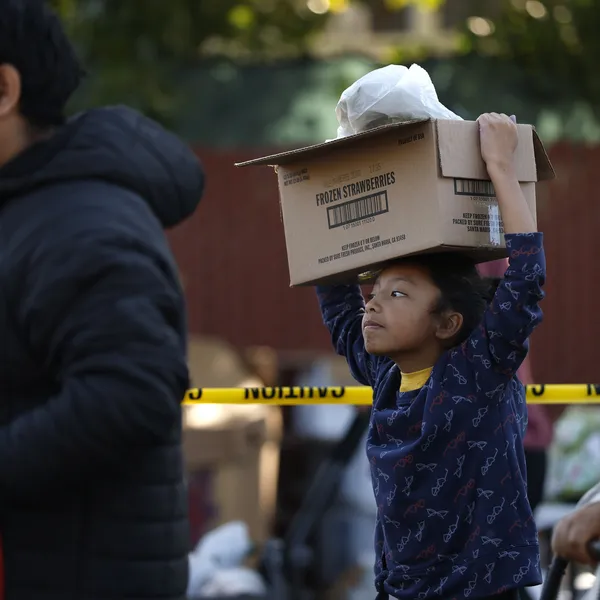Trump's TANF Cut Would Hurt the Poorest Families, and States Might Make Them Worse
President Trump's proposed $2.2 billion cut to the Temporary Assistance for Needy Families (TANF) program in 2018 would reduce states' federal TANF funds by 10 to 18 percent (depending on whether a state receives TANF Contingency Funds), as the table below shows. Over the next decade, the TANF cut would total $22 billion.
President Trump's proposed $2.2 billion cut to the Temporary Assistance for Needy Families (TANF) program in 2018 would reduce states' federal TANF funds by 10 to 18 percent (depending on whether a state receives TANF Contingency Funds), as the table below shows. Over the next decade, the TANF cut would total $22 billion.
Moreover, states have great flexibility to spend TANF funds as they wish, and they might be pressured to use some of their reduced TANF funds to plug their budget holes. That's because the Trump budget proposes to cut some $2.5 trillion over the next decade across programs for low- and moderate-income people, including a range of important programs for which the states receive significant federal funds.
To understand the magnitude of the TANF cuts in 2018 alone, consider:
- The cuts would total more than the amount that all states combined spendon work programs.
- In 11 states, the cuts would be more than half of what the states spend on basic assistance.
- In 18 states, the cuts would be more than half of what the states spend on child care assistance.
With their flexibility under TANF, states could respond to the cuts in a number of ways. They could, for instance, cut all of their TANF-funded programs by an equal percentage, or they could target the cuts in one area such as basic assistance.
Several states face budget shortfalls, they often look first to core TANF activities, like basic assistance, for savings. In response to increased need and budget shortfalls caused by the Great Recession, several states made disproportionate cuts to cash assistance by tightening time limits, reducing benefits, or scaling back eligibility. Still, because many states already spend so little on basic assistance, they likely would also have to cut popular programs like child care, state earned income tax credit programs that support working families, and child welfare programs that provide services to some of the most vulnerable children.
Several states face budget shortfalls this year and are already making tough decisions about how to balance their budgets. Some are considering cutting TANF basic assistance programs. The President's proposals would make it harder for states to fulfill TANF's core purpose: to provide financial support for families in need and help parents find work.
Fourteen states already have ten or fewer families on TANF for every 100 families in poverty. The President's TANF cuts would force states to push more families off assistance and deeper into poverty.
An Urgent Message From Our Co-Founder
Dear Common Dreams reader, The U.S. is on a fast track to authoritarianism like nothing I've ever seen. Meanwhile, corporate news outlets are utterly capitulating to Trump, twisting their coverage to avoid drawing his ire while lining up to stuff cash in his pockets. That's why I believe that Common Dreams is doing the best and most consequential reporting that we've ever done. Our small but mighty team is a progressive reporting powerhouse, covering the news every day that the corporate media never will. Our mission has always been simple: To inform. To inspire. And to ignite change for the common good. Now here's the key piece that I want all our readers to understand: None of this would be possible without your financial support. That's not just some fundraising cliche. It's the absolute and literal truth. We don't accept corporate advertising and never will. We don't have a paywall because we don't think people should be blocked from critical news based on their ability to pay. Everything we do is funded by the donations of readers like you. Will you donate now to help power the nonprofit, independent reporting of Common Dreams? Thank you for being a vital member of our community. Together, we can keep independent journalism alive when it’s needed most. - Craig Brown, Co-founder |
President Trump's proposed $2.2 billion cut to the Temporary Assistance for Needy Families (TANF) program in 2018 would reduce states' federal TANF funds by 10 to 18 percent (depending on whether a state receives TANF Contingency Funds), as the table below shows. Over the next decade, the TANF cut would total $22 billion.
Moreover, states have great flexibility to spend TANF funds as they wish, and they might be pressured to use some of their reduced TANF funds to plug their budget holes. That's because the Trump budget proposes to cut some $2.5 trillion over the next decade across programs for low- and moderate-income people, including a range of important programs for which the states receive significant federal funds.
To understand the magnitude of the TANF cuts in 2018 alone, consider:
- The cuts would total more than the amount that all states combined spendon work programs.
- In 11 states, the cuts would be more than half of what the states spend on basic assistance.
- In 18 states, the cuts would be more than half of what the states spend on child care assistance.
With their flexibility under TANF, states could respond to the cuts in a number of ways. They could, for instance, cut all of their TANF-funded programs by an equal percentage, or they could target the cuts in one area such as basic assistance.
Several states face budget shortfalls, they often look first to core TANF activities, like basic assistance, for savings. In response to increased need and budget shortfalls caused by the Great Recession, several states made disproportionate cuts to cash assistance by tightening time limits, reducing benefits, or scaling back eligibility. Still, because many states already spend so little on basic assistance, they likely would also have to cut popular programs like child care, state earned income tax credit programs that support working families, and child welfare programs that provide services to some of the most vulnerable children.
Several states face budget shortfalls this year and are already making tough decisions about how to balance their budgets. Some are considering cutting TANF basic assistance programs. The President's proposals would make it harder for states to fulfill TANF's core purpose: to provide financial support for families in need and help parents find work.
Fourteen states already have ten or fewer families on TANF for every 100 families in poverty. The President's TANF cuts would force states to push more families off assistance and deeper into poverty.
President Trump's proposed $2.2 billion cut to the Temporary Assistance for Needy Families (TANF) program in 2018 would reduce states' federal TANF funds by 10 to 18 percent (depending on whether a state receives TANF Contingency Funds), as the table below shows. Over the next decade, the TANF cut would total $22 billion.
Moreover, states have great flexibility to spend TANF funds as they wish, and they might be pressured to use some of their reduced TANF funds to plug their budget holes. That's because the Trump budget proposes to cut some $2.5 trillion over the next decade across programs for low- and moderate-income people, including a range of important programs for which the states receive significant federal funds.
To understand the magnitude of the TANF cuts in 2018 alone, consider:
- The cuts would total more than the amount that all states combined spendon work programs.
- In 11 states, the cuts would be more than half of what the states spend on basic assistance.
- In 18 states, the cuts would be more than half of what the states spend on child care assistance.
With their flexibility under TANF, states could respond to the cuts in a number of ways. They could, for instance, cut all of their TANF-funded programs by an equal percentage, or they could target the cuts in one area such as basic assistance.
Several states face budget shortfalls, they often look first to core TANF activities, like basic assistance, for savings. In response to increased need and budget shortfalls caused by the Great Recession, several states made disproportionate cuts to cash assistance by tightening time limits, reducing benefits, or scaling back eligibility. Still, because many states already spend so little on basic assistance, they likely would also have to cut popular programs like child care, state earned income tax credit programs that support working families, and child welfare programs that provide services to some of the most vulnerable children.
Several states face budget shortfalls this year and are already making tough decisions about how to balance their budgets. Some are considering cutting TANF basic assistance programs. The President's proposals would make it harder for states to fulfill TANF's core purpose: to provide financial support for families in need and help parents find work.
Fourteen states already have ten or fewer families on TANF for every 100 families in poverty. The President's TANF cuts would force states to push more families off assistance and deeper into poverty.

